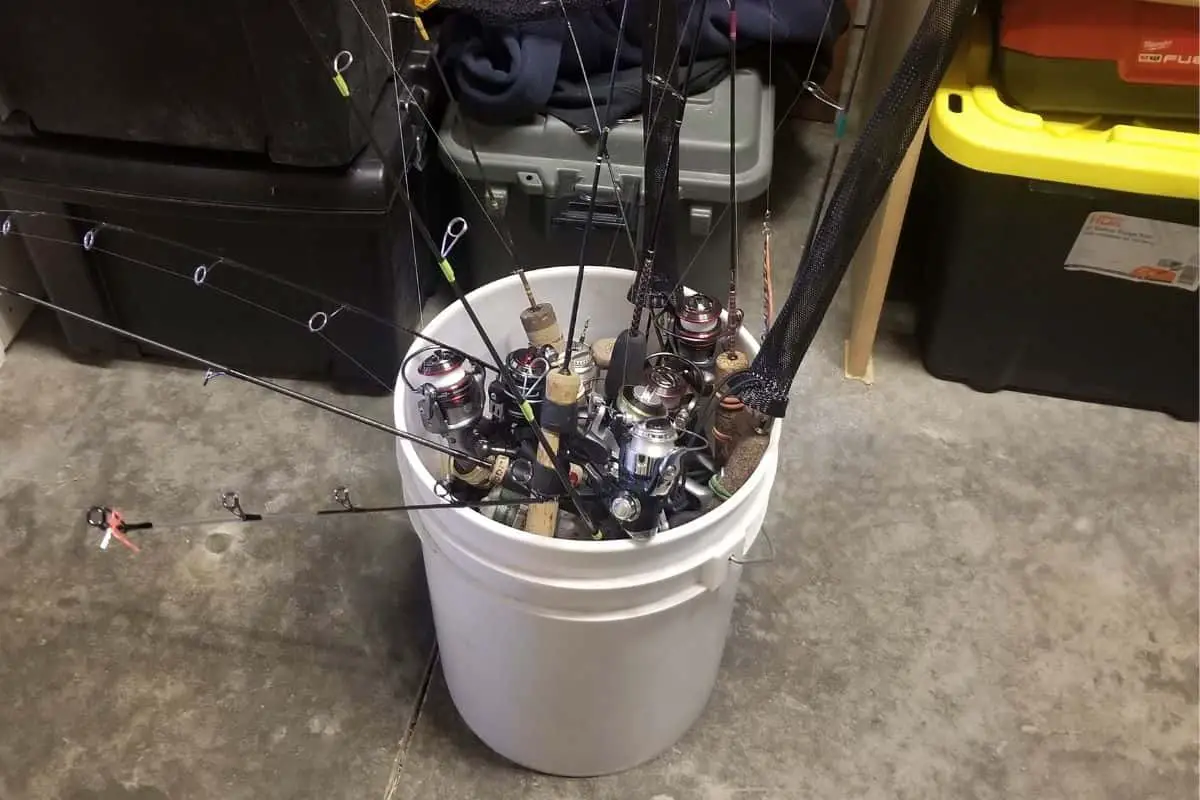Ice fishing can be brutally hard on gear, and with ice fishing rods becoming more lightweight and increasingly expensive, you’ll want to protect that investment. So how do you transport ice fishing rods?
As a general rule, ice fishing rods should be transported in padded cases (hard-sided or soft-sided) with no tension on the line. If one has to transport them with hooks or lures still attached, a simple solution to prevent tangles is to use rigid rod tubes and a soft-sided case with extra padding.
Quality rods can easily range in price from $50.00 to over $140.00! Most ice fishermen I run across will carry six or more rods when on the ice. That’s a significant investment to protect!
With today’s hi-tech blank materials, rods can be the most expensive and fragile pieces of ice fishing gear you have.
You want to take good care of them and protect them against snapping and against the elements.
There are a few handy solutions and techniques for transporting your ice rods without damaging them or getting the lines tangled up, so let’s examine them in more detail.
Transporting Ice Fishing Rods – The Basics
We’ve all seen people walking across the ice carrying their gear in their arms or pulling a sled full of equipment behind them. That might work, but…
What About 5-Gallon Buckets?
When I first began ice fishing, I had four rods pre-rigged with spoons and jigs. That way, I didn’t have to cut off and tie another lure on when I wanted a different lure.
I used a 5-gallon bucket in those days. (I still carry a bucket but use it for other purposes rather than carrying rods.)
The simplest way, and the way many carry their rods, is to transport them in the same five-gallon bucket used to transport all your other gear. That way, they will be easy to lift out when you need them, right?
The problem with transporting your rods bouncing around freely in a bucket is that you will end up with broken tips and tangled lines! Any exposed hooks will inevitably become a knotted mess.
Transporting rods in buckets is especially bad with high-dollar custom rods. Although the expensive rods are strong for their weight and size, they can be susceptible to easy breakage.

An additional problem with a bucket, if you are not using some grooved holder on the rim to hold your ice rods, is that they will be all tangled up by the time you come to use them.
What About Carrying Ice Rods in Your Ice Fishing Sled
Once I started carrying more gear onto the ice, a bucket was no longer big enough! So I started using an ice sled to pull my fishing gear behind me as I walked onto the ice.
I found I had the same tangles mess as I did with the bucket, and I even broke two ice rods the first month of the season!
With tackle boxes, ice augers, a cooler, etc., many items could damage my ice rods while bouncing over ice heaves and up and down lake banks!
If you carry rods in a sled behind you, use a padded rod case!
We recommend the following tips for looking after your ice rods.
Always Carry Your Rods in a Padded Case
Transporting your rods to and from the lake where you’re fishing means loading them onto trucks and bouncing over rough snow-covered roads. Such scenarios present a lot of opportunities for your rods to break.
However, a high-quality, hard-sided rod case will protect your rods against damage.
A key consideration is how you get the rods into the case.
Some cases require you to push your rod in from the bottom, leading to a risk of the tips catching and bending and even snapping.
For this reason, we recommend a side-loading case, which opens like a briefcase or a gun case. Such a case allows you to set your rods horizontally, eliminating the risk of breakage unless you close the rod case with the rod tip sticking out.
These cases afford excellent protection, but their downsides are they are cumbersome at times to transport, take up a lot of room in your shack, and most have low capacities.
Using rigid rod tubes allows you to slip your rod inside with the line and hook still attached and not worry about tangles.
You can put the rod tubes into soft-sided rod lockers for storage and transportation.
Soft-sided rod lockers are easy to carry, tie to a machine such as a snowmobile, or stash in a shack.
Because anything that can bounce freely on the ice will not have a long life, make sure to pad the soft-sided rod lockers. You can do this by stuffing rags into the zippered compartments on the outside.
Doing so prevents the reels from directly contacting hard surfaces such as the ice or your snow machine.
Meanwhile, the rods themselves are protected by the rod tubes. These are rigid tubes that you slide your rod into, with a cutaway for the reel that keeps the rods protected and the lines from tangling.
However, rod tubes require you to push the rod tip from the bottom, and if you are in a hurry, you may end up with a broken tip. So be sure to be careful with your gear.
A DIY alternative to commercial rod tubes such as HT Enterprise’s Polar Rod Guards is 2″ PVC tubes with a slot cut out to accommodate the reel. Meanwhile, a soft-sided guitar case is an alternative to a soft-sided rod locker.
Never store a rod with a loaded tip.
Storing your rod with tension on the line and a bend in the rod’s tip leads to a so-called loaded tip.
A loaded tip is often the result of hooking the jig into the hook keeper and then reeling down to prevent the hook from coming off the hook keeper. It can also result from reeling the hook to the rod’s top eyelet and reeling tension.
If a fiberglass rod is stored with a loaded tip, the fiberglass in the tip will take a set or permanent bend.
A loaded tip is also pre-stressed and liable to break. Carbon fiber rods with fast tips
are especially prone to this.
We advise storing your rods with no tension on the line.
How To Position Your Ice Fishing Rods In Their Case
Because you never know what sort of fish you will come across, whether crappie, bluegill, pike, or bass, you may desire to have various rods with different set-ups.
Transporting these all lying in the same orientation (all the reels at the same end) is not an efficient way to use space, and you will rapidly run out of room for all your rods.
For this reason, we recommend staggering your rods and lying some with the reels at one end of the case and some at the other end.
Conclusion
Because ice rods are fragile equipment, you should transport them well protected.
It would be best if you did not transport them with tension on the line. We also recommend avoiding using a five-gallon bucket to transport your rods and opting for a well-padded case, whether hard-sided or soft-sided.
References
Have fun and stay safe out there!

